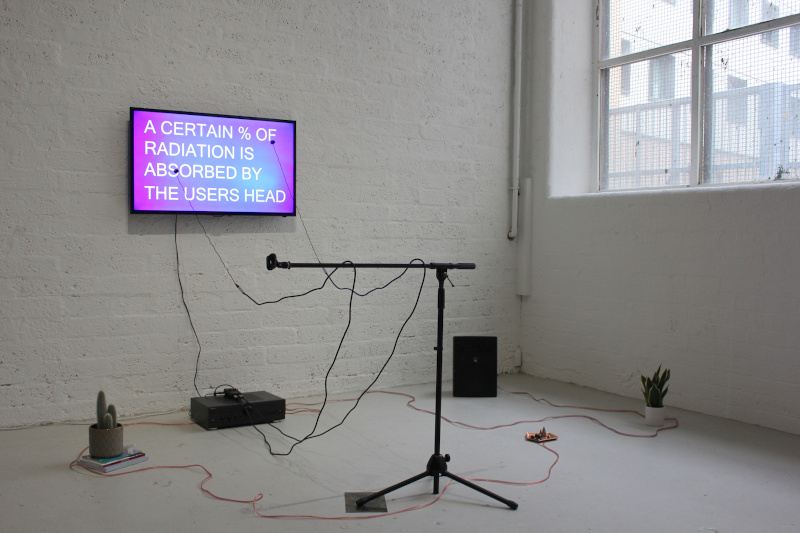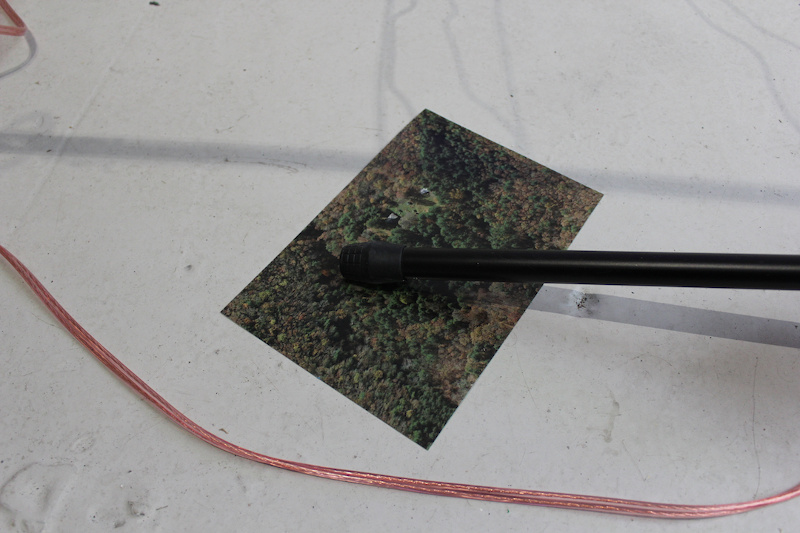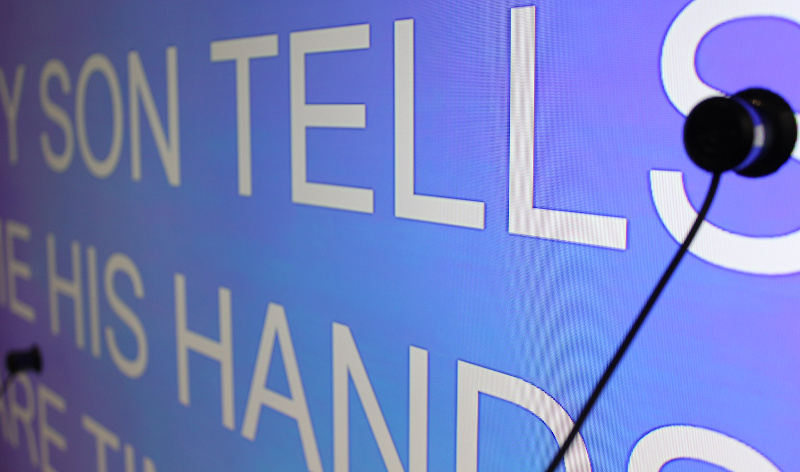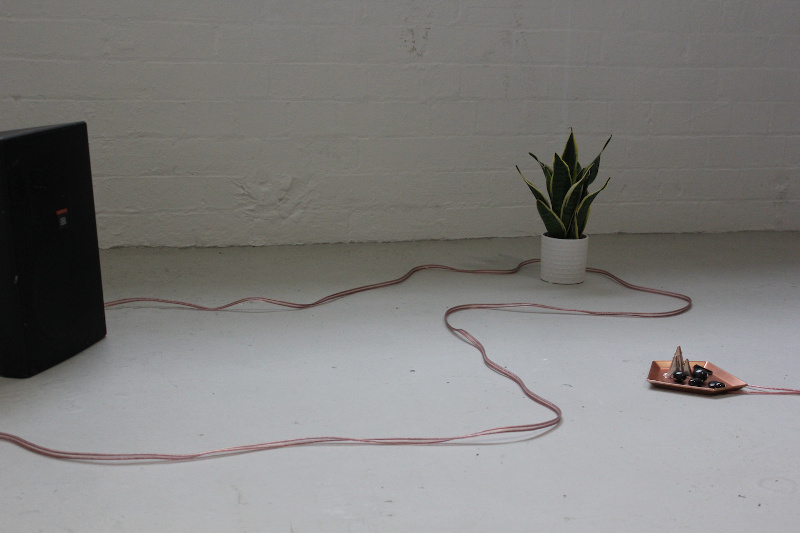
Go Live in the Middle of Nowhere Obviously
by MARK PETER WRIGHT
- View Mark Peter Wright's Biography
Mark Peter Wright is an artist-researcher working at the intersection of sound, ecology and contemporary art.
Go Live in the Middle of Nowhere Obviously
by MARK PETER WRIGHT
"Many environmental harms are silent, invisible, and difficult to detect" (Alaimo 175).
A large plasma screen fixed to a gallery wall displays a series of statements: "Towns are slowly turning into micro-ovens. A certain % of radiation is absorbed by the users head. Eating healthy and juicing isn't enough. Will your front yard be a 5G cell tower site? Go live in the middle of nowhere obviously." Questions and statements fill the vertical and horizontal lengths of the screen, flashing on and off amongst a vibrant mix of background colors. Attached to the interface itself are two electromagnetic microphones. Stuck to the display they resemble giant tentacles, draped through the space over a microphone stand that has been removed from its usual duties. Under its leg is a photograph that depicts a green space from above. Cables run in all directions across surfaces, objects and air. On the floor is a speaker. Either side of the screen two plants. One is a snake plant the other a cactus. Underneath the latter, a stack of books with titles The Non-Tinfoil Guide to EMFs (2017) and Shungite: Protection, Healing and Detoxification (2014). Minerals and black stones occupy a copper coated dish which completes one end of the wired circuit. Sound emits from the speaker, it trembles and pulses, blinks and shifts with each flash of the screen's messaging mantra.
The preceding commentary describes an installation and research project I call "Go Live in the Middle of Nowhere Obviously." The work was part of a group exhibition titled "Hyperobjects" at Catalyst Arts, Belfast, 2019.1 It draws attention to electromagnetic hypersensitivity (EHS), a condition that effects the health of humans and nonhumans. Magnetic fields are part of the earth's natural process of defense against solar winds. They are also produced from man-made sources: electronic devices such as phones, televisions and wi-fi. Electromagnetic atmospheres radiate from technologies and infrastructures in waves that can reportedly produce symptoms such as burning sensations, chronic fatigue and nausea. As yet there is no official acceptance of the condition within scientific or medical disciplines.
The curatorial impetus for the exhibition was inspired by philosopher Timothy Morton's theory of "hyperobjects." Such a term denotes anthropogenic objects that are distributed across time and space. They exist beyond the timescale of human life or indeed, human comprehension. "Materials from humble Styrofoam to terrifying plutonium will far outlast current social and biological forms. We are talking about hundreds and thousands of years" (Morton 130). Feminist scholar Heather Davis (2015) explores plastic as an everyday actor to bring a sense of intimacy into the potentially abstract study of hyperobjects. Anthropogenic materials and phenomena produce forms of "slow violence," scholar Rob Nixon's (2011) term for the ongoing geo-health inequalities and consequences of invisible agents such as chemicals, toxins and waste. Morton's concept of hyperobjects is a powerful one for thinking with atmosphere and sound,2 but it was the title of the group exhibition and not the specific topic that my own work operated upon. Instead, I routed the word atmosphere through philosopher Gernot Böhme's (2016) work and the suggestion that ambiance "radiates" through environments and subjects.3 The relationship derives its complexity in that such movements are hidden or difficult to apprehend. The focus on radiant positions atmospheres as active; operating through locations and bodies at scales difficult to perceive or define in a traditional diagnostic sense. The word also alludes to something more toxic in terms of radiation itself. For this practice-based investigation I wanted to explore the ambient fields of electromagnetism as an inaudible presence, a slow violence that affects bodies intimately over the long reach of time. Moreover, listening to situated testimonies within an assemblage of media noise, I hoped to draw attention towards the marginalized "non-expert" as a co-constituent actor of sensate knowledge.

Figure 1. Go live in the Middle of Nowhere, installation view, copyright the author, 2020.
In 2004, the World Health Organization (WHO) convened in Prague for an international workshop on EHS. The working group focused on environments and situations in which EHS was likely to develop; the home or workplace, as well as common physiological and epidemiological responses. A new term - Idiopathic Environmental Intolerance (IEI) - was proposed to shift research into more ecologically valid terrain, where causality could be traced through the triangulation of environments, technologies and bodies. The report suggested physicians and clinicians include medical, workplace and psychological evaluation into their diagnostic checks. Although focused on human impact it is worth noting nonhuman wildlife also signal the signs of increasing electromagnetic ambience. Research has evidenced birds, insects and migratory animals are particularly vulnerable to anthropogenic radiation as receptor organs, used to navigate earth's magnetic field, become exposed and altered.4
For all the research and information on EHS, the condition is not augmented in general medical practice nor, I would argue, within sound arts history of dealing with the electromagnetic spectrum. Sonic works have tended to concentrate efforts primarily on the vibrant and musical energies of such matters, the sounds of cosmic events and the rhythms of urban infrastructure.5 Tuning the ear towards worlds above and below the human range of hearing productively expands anthropocentric notions of a singular acoustic field. However, such aesthetic precedents might also be said to lack critical engagement in the consequences of ambient radiation itself. Within a time of climate catastrophe, the question becomes how can a vibrant materialist appreciation of the electromagnetic spectrum be entangled with a sensitivity towards its socio-political impacts upon planetary health, across all species?
Due to the precarious status of EHS, "sensitives" must relocate the site of diagnosis towards the margins of legitimate knowledge. Practical ways of coping with electromagnetic ambience is often crowd sourced through online chatrooms. In addition to facilitating collective discussion on symptoms and remedies, digital space offers social intimacy as mental health and well-being become part of an ecology of care. Conversations are as broad as one might expect and sifting through the data I learn about plants, diets, home insulation, juice recipes, mineral healing, quiet zones, government policy, sound frequencies, sleep patterns, philosophy and much more. Within this kaleidoscopic mix I am aware of the avalanche effect of opinion and the consequent threat of its malpractice. So too I notice my own privilege, as the artist researcher who occupies a dual inside-outside status.6 When might atmospheres be considered toxic? How can the sites of para-expertise be re-claimed as valid and worthy of attention? How might the multitude of voices and advice be decoded and communicated? Can sound, as a material discursive praxis, cope with the multi-sensory demands of such conditions along with the supply chain of causality that so often goes unheard?

Figure 2. Go live in the Middle of Nowhere, detail, copyright the author, 2020.
Throughout the installation messages were broadcast on a plasma screen (see figures 1 and 3). These were excerpts from a public domain chat room for EHS discussion.7 Creative commons content, specific to EHS, was repurposed into a form of public address. Explorative comments and diagnosis took on an ambiguous yet intimate sense of urgency and meaning. The typography and scale of text drew upon research into health warning aesthetics, from cigarette packaging to hazard signage. I hoped the billboard style exuberance would performatively function as a campaign for these marginalized messages to be heard. Each statement was followed by an attribution that included a user name, time, date and subject title in a format that borrowed from academic referencing etiquette. As excerpts flashed on and off, electromagnetic microphones attached to the screen "listened" to the technological process itself. Live feedback, heard primarily as fluctuating noise, cloaked the diorama of related objects and materials. Books on DIY interventions and mineral healing were offered as meta-materials for reading within the enacted scene of listening; a palimpsest of relations that sounded the margins of bodies, health and hearing. The installation endeavored to connect key concerns through its performative structure. It was a staged quasi-domestic space in which plants, books and media acted within the surroundings of a white walled gallery. The sound of live televisual feedback was broadcast at low level, perceptible but not intrusive to the ear. This became a vital part of the artwork in terms of setting an affective yet ignorable sense of presence that would mirror the function of electromagnetic ambience itself. The legible screen text slogans were fed back into the room as noise in the hope of adding another element of sensory obfuscation, and to ask how do we make meaning in the absence of clear signal? Upon reflection the installation became an expanded form of "sensory journalism" in which situated perspectives, stories of well-being and health, were mediated beyond the traditions of text, screen or sound based media alone. The sculptural relations of the work enabled its materiality and concepts to be inhabited and co-produced.

Figure 3. Go live in the Middle of Nowhere, detail, copyright the author, 2020.
Philosopher Isabelle Stengers (2015) suggests we need to "listen to that which insists, obscurely" (19). Stenger's comment helps draw attention towards the peripheries of sensory experience, and to the prospect of noticing electromagnetic ambience as culturally credible. EM radiation is certainly an obscure, out of range and under acknowledged phenomena. It is felt through bodies rather than heard as sound, diagnosed through chatrooms rather than waiting rooms. Atmosphere, so often framed as fleeting yet all encompassing, becomes reterritorialized through the EHS corporeal-lens. No longer benign or immersive, EM ambience transfuses, impacts and lingers across bodies, technologies and sites.
Feminist scholar Stacy Alaimo (2010) proposes the term "transcorporeal" as a way of thinking-with the multiple exposures that reconfigure bodies in times of environmental pollution. EM radiation, might count as what Alaimo calls a "deviant agent" (113-140), something we must begin to practice with as much as the Earth's more natural energies. Speaking on the embodied knowledge of lives lived under the strain of invisible pollutants, Alaimo (2016) states "The chemically sensitive move through the world using their own bodies as monitoring devices" (173). Framed as such, the EHS sufferer transforms into a human sensor that inscribes ambient noise, rewriting matters of health and well-being with the body itself. The EHS subject should not be cast simply as a lay listener, but reconsidered as a techno-citizen-subject that captures veiled changes in the environment without recourse to scientific instrumentation. The so-called "sufferer" becomes the situated and subjective expert amongst an ecology of senses. Chatroom conversations offer an alternative medical corpus, a testimonial trail that might illuminate many of the missing links between environments, technologies and bodies; if we begin to notice them.

Figure 4. Go live in the Middle of Nowhere, detail, copyright the author, 2020.
Art has always been invested in sensory and subjective knowledge but as Alaimo reminds us, it does well to remain tethered to material-political discourse:
environmental illness, needs to be allied not only with disability rights movements, but with anti-toxin, environmental, and environmental justice movements in order to forge an expansive, interwoven, material politics in which the political does not become the merely personal (Alaimo 124).
Similarly, by focusing on the electromagnetic spectrum in a time of vast anthropogenic change, I would argue a responsive ear leans towards a plurality of practice, knowledge and effects as much as the lure of sonic frequencies themselves. Geomagnetic storms are vital to hear but so too are the less enchanting murmurs of marginalized bodies, chatrooms, and the infra ordinary of televisions and phones. Disciplines such as acoustic ecology, long invested in tracking industrial noise, might want to include the less audible world of contemporary technology, and its futurological footprint as part of a "post-natural" endeavor.8 This would be an ambient ecology that traces obstinate intimacies and relations found in "radiant infrastructures" as media scholar Rahul Mukherjee (2020) calls them, the media and mediations involved in producing electromagnetic radiation. The consequence of thinking-with practice inevitably falls on artists and artworks to notice and entangle the deviant sonic agents of environmental change: to offer "slow hope" (Mauch 2019) against the slow violence of environmental degradation, across all knowledge making bodies.
Works cited
Alaimo, S. Bodily Natures: Science, Environment, and the Material Self. Indiana University Press, 2010, p.124, pp. 113-140.
Alaimo, S. Exposed: Environmental Politics and Pleasures in Posthuman Times. University of Minnesota Press, 2016, p. 173, 175.
Balmori, A. "Anthropogenic Radiofrequency Electromagnetic Fields as an Emerging Threat to Wildlife Orientation." Science of the Total Environment, 2015, pp. 58-60.
Böhme, G. The Aesthetics of Atmospheres. Routledge, 2016.
Davis, H. "Toxic Progeny: The Plastisphere and Other Queer Futures." Philosophia, vol. 5 no. 2, 2015, pp. 231-250.
Electrical Sensitivity Discussion Forum. Online. http://es-forum.com/
Hinterding, J. Spectral CD. ANTIOPIC, 2003.
Kubisch, C. Magnetic Fields CD. Important Records, 2011.
Martino, R. Shungite: Protection, Healing and Detoxification. Healing Arts Press, 2014.
Mauch, C. Slow Hope: Rethinking Ecologies of Crisis and Fear. RCC Perspectives, 2019.
Mild, K.H., et al. "Electromagnetic Hypersensitivity Proceedings." International Workshop on Electromagnetic Field Hypersensitivity, WHO, Prague, Czech Republic, October 25-27, 2004.
Morton, T. The Ecological Thought. Harvard University Press, 2010, p. 130.
Mukherjee, R. Radiant Infrastructures. Duke University Press, 2020.
Nixon, R. Slow Violence and the Environmentalism of the Poor. Harvard University Press, 2011.
Pineault, N. The Non-Tinfoil Guide to EMFs. N&G Media Inc, 2017.
Rogoff, I. "Geo-cultures: Circuits of Arts and Globalization." 2006, p. 5.
Stengers, I. In Catastrophic Times: Resisting the Coming Barbarism. Open University Press, 2015, p. 19.
Wright, M.P. "Post-Natural Sound Arts." Journal of Sonic Studies, vol. 14, 2017.
Wright, M.P. "Go Live in the Middle of Nowhere Obviously." Hyperobjects Group Exhibition, Catalyst Arts, Belfast, November 7-December 5, 2019.
Footnotes
- See: https://www.catalystarts.org.uk/hyperobjects (accessed February 2020). ↩
- Wright, M.P. "Post-Natural Sound Arts," Journal of Sonic Studies, vol. 14, 2017. https://www.researchcatalogue.net/view/292319/292320/0/0 (accessed February 2020). ↩
- It is interesting to note Böhme's writing on atmospheres is concerned with ecological aesthetics and demonstrating how a subject like toxicity is also an aesthetic and interpretative problem as much as a material or bodily one. My own exhibition mixed both ends of the spectrum but clearly endeavored to reclaim the body as a sensate and valid register to matters often imperceptible. See: Böhme, G. The Aesthetics of Atmospheres. Routledge, 2016. ↩
- Balmori, A. "Anthropogenic radiofrequency electromagnetic fields as an emerging threat to wildlife orientation." Science of the Total Environment, 2015, pp. 58--60. ↩
- See: Hinterding, J. Spectral CD. ANTIOPIC, 2003; Kubisch, C. Magnetic Fields CD. Important Records, 2011. ↩
- Irit Rogoff claims practitioner-researchers occupy "a dual positionality of being spatially located in an inside and paradigmatically on the outside, or vice versa." Rogoff, I. "Geo-cultures: Circuits of Arts and Globalization." 2006, p 5. Available from: https://onlineopen.org/geo-cultures (accessed November 2019). ↩
- See: http://es-forum.com/ (accessed November 2019). ↩
- Post-natural is a term that arrives as a consequence of the proposed Anthropocene era. It refers to the irrevocable impact humans have had upon nonhuman species and phenomena, and indicates Nature can no longer be conceptualized or practiced as separate from human culture. I am interested in what a term like this means to practices such as field recording and acoustic ecology, disciplines that have historically separated nature and industry, silence and noise, humans and nonhumans. Further writing on this subject is available from: https://www.researchcatalogue.net/view/292319/292320/0/0 (accessed February 2020)

